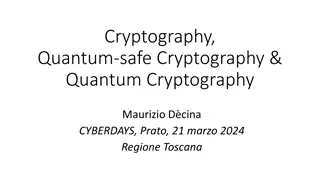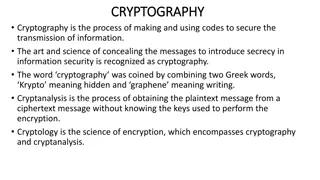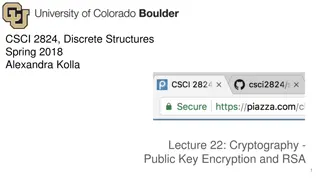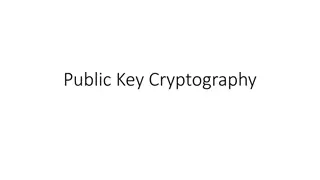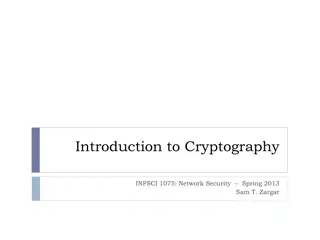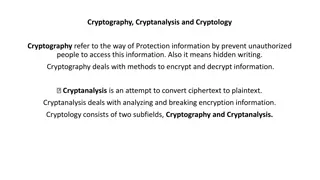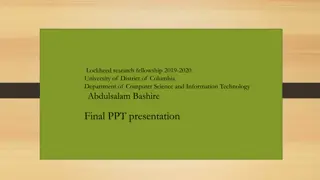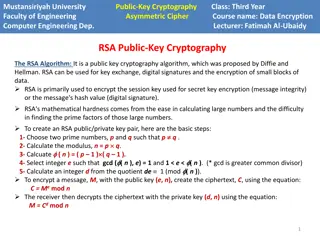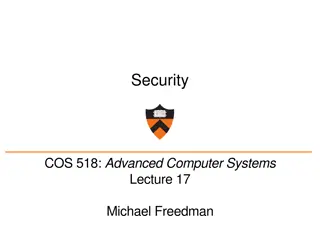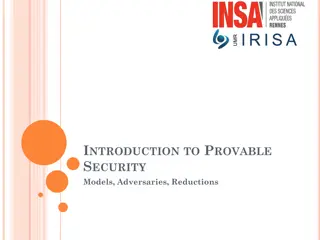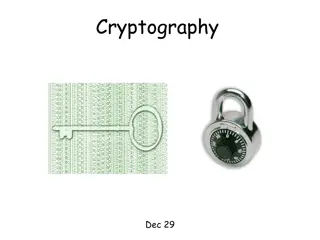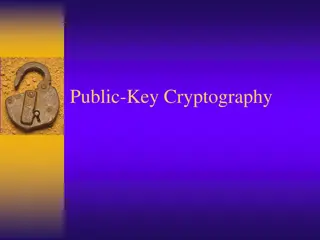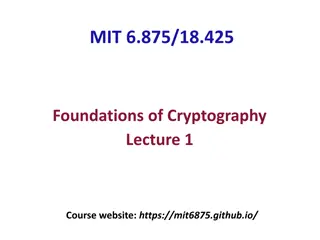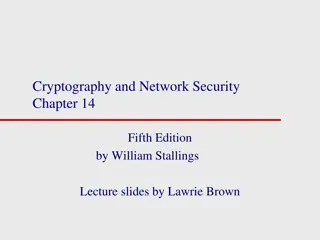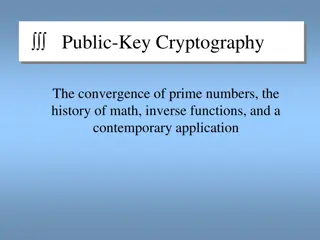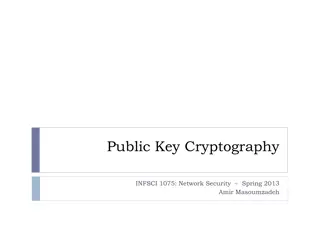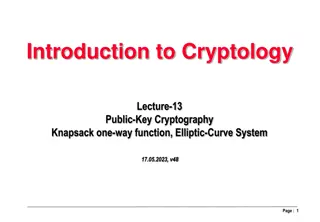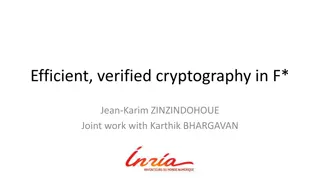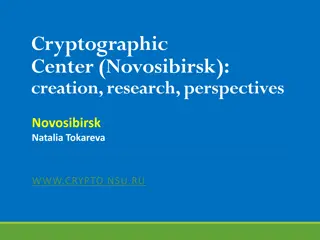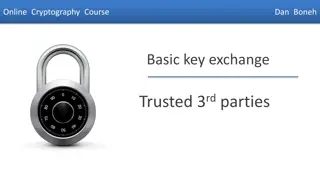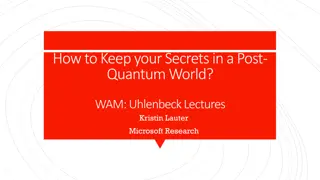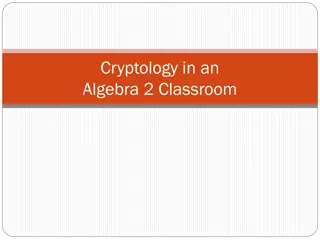Public Key Cryptography and Modern Cryptology
Delve into the world of cryptology with a focus on public key cryptography, as pioneered by Whitfield Diffie, Martin Hellman, and James Ellis. Explore the revolutionary concept of using public and private keys for secure communication without the need for a prior key exchange. Uncover the insights and developments that have shaped modern cryptography and information security.
Download Presentation

Please find below an Image/Link to download the presentation.
The content on the website is provided AS IS for your information and personal use only. It may not be sold, licensed, or shared on other websites without obtaining consent from the author.If you encounter any issues during the download, it is possible that the publisher has removed the file from their server.
You are allowed to download the files provided on this website for personal or commercial use, subject to the condition that they are used lawfully. All files are the property of their respective owners.
The content on the website is provided AS IS for your information and personal use only. It may not be sold, licensed, or shared on other websites without obtaining consent from the author.
E N D
Presentation Transcript
Cryptology 4. Public KeyCryptography Prof. David Singer Dept. of Mathematics Case Western Reserve University Fall 2012
Modern Cryptography New Directions in Cryptography, by Whitfield Diffie and Martin Hellman, 1976.
Modern Cryptography New Directions in Cryptography, by Whitfield Diffie and Martin Hellman, 1976. (Also classified publication by James Ellis in 1970, declassified in 1997.) J H Ellis, The Possibility of Secure Non-Secret Digital Encryption, CESG Report, January 1970.
James Ellis (1924-1997) It was obvious to everyone, including me, that no secure communication was possible without a secret key Can we produce a secure encrypted message, readable by the authorised recipient without any prior secret exchange of the key etc?
James Ellis (1924-1997) This question actually occurred to me in bed one night, and the proof of the theoretical possibility took only a few minutes. The only remaining question was Can it be made practicable? This took a while to answer.
What is Public Key Crypto? Bob has two keys: a public key, which is available to anyone, and a private key. Alice uses the public key to lock (encrypt); Bob uses the private key to unlock (decrypt).
What is Public Key Crypto? Alice can communicate without having previously contacted Bob. No one but Bob can decrypt the message. But how can this be done??
One-Way Functions What is a function? It is an input-output device.
One-Way Functions Going backwards may be harder. Even if you know the rule.
Properties of one-way functions If y=f(x) is one-way, then: 1. Given x, it is easy to get y. 2. Given y, it is (generally) hard to recover x. 3. Given x, it is hard to find another x with f(x)=f(x ).
One-way trapdoor functions Given x, easy to compute y=f(x) Given y, hard to recover x Trapdoor: Extra information k Given k and y, it is easy to recover x =T(y,k)
How public-key works Bob publishes his public key B Alice wants to send message m. She Encrypts m with Bob s public key by one-way function: c=EB(m) Nobody can recover m from c. That is, nobody except Bob.
How public-key works Bob uses his secret key k to decrypt the message c: m= DB(c,k) The mathematical formula we need is DB(EB(m),k)=m
But can this be done?? First proposed system was apparently developed by Clifford Cocks at GCHQ (British Intelligence Government Communications Headquarters) in 1973. Like Ellis, Cocks could not publish his results. The first published system, RSA, was developed in 1977 at MIT.
William Stanley Jevons (1835-1882) From The Principles of Science (1874): What two numbers multiplied together will produce 8616460799? I think it unlikely that anyone but myself will ever know. (Factored by Derrick Lehmer in 1903: 89681 x 96079)
Creating a mathematical secret Multiplying numbers is easy But factoring numbers is hard Basis for RSA cryptosystem: L.M. Adleman, R.L. Rivest and A. Shamir, 1978
Warning! Technical stuff ahead next three slides!
The RSA Cryptosystem Generate two large prime numbers p and q. Multiply them together to get very large number N. Compute Euler Totient T=(p-1)(q-1) Choose numbers e and d for which the product e times d leaves remainder 1 when divided by T. Publish (N, e) (this is the public key). Keep the rest secret.
The Encryption algorithm Turn message into a large number m (encoding) Compute (this is the remainder left when th is divided by N). The number c is the encryption of the message!
The Decryption Algorithm Compute Decode m to get the message. Mathematical principle: If you know the values of m, e, and N, you can compute c. If you know the values of c, d, and N, you can compute m. BUT if you know c, e, and N and can t factor N, you (probably) can t get m.
The one-way function In RSA, the one-way function is where The idea is that if we know how to factor N we can take eth roots, but not otherwise.
The one-way function Anyone can compute eth powers, so anyone can send a message to Bob. But only Bob knows how to take eth roots, so only Bob can read the message.
Diffie-Hellman Key Exchange The idea of Diffie and Hellman allows two people who have never met to establish a secret key. It is based on the idea that computing powers of a known number modulo a known number is a one-way function.
Diffie-Hellman Key Exchange (Math-heavy version!!) Alice and Bob publicly agree on a large number p and a number z. Alice picks a random secret number a, and Bob picks a random secret number b. Alice computes Bob computes
Diffie-Hellman Key Exchange (Math-heavy version!!) This is done privately. Alice sends A to Bob and Bob sends B to Alice. This can be done publicly. But now Alice and Bob can each compute a secret number K, given by:
Diffie-Hellman Key Exchange (With numbers) Alice and Bob publicly agree on a large number 11 and a number 7 Alice picks a random secret number 3, and Bob picks a random secret number 6. Alice computes Bob computes
Diffie-Hellman Key Exchange (with numbers) This is done privately. Alice sends 2 to Bob and Bob sends 4 to Alice. This can be done publicly. But now Alice and Bob can each compute a secret number K, given by:
Diffie-Hellman Key Exchange Here is a graphic illustration:
Diffie-Hellman Key Exchange Another graphic illustration:
Diffie-Hellman Key Exchange The point is, Alice and Bob have never met before, but they have publicly agreed on a private secret! Now the secret number K is used as the secret key for doing ordinary cryptography!
Comments Diffie-Hellman only produces a random number. It is not itself a cryptosystem. RSA is a full-fledged cryptosystem; two people with public keys can exchange private messages.
Comments In practice, only one party has a public key. (Amazon has a public key, but you don t need one.) Lots of details. In particular, how do you actually get someone s public key?


